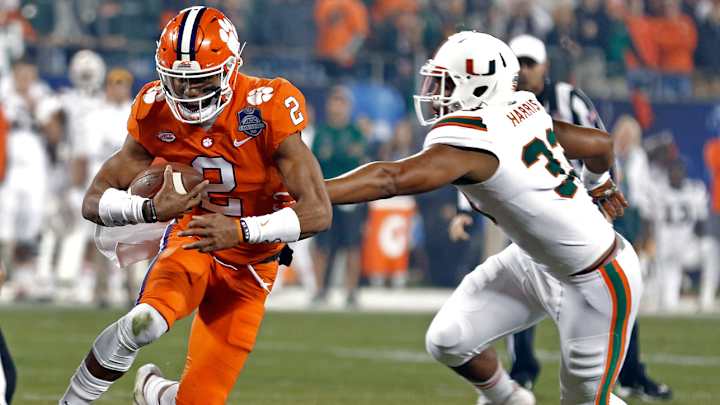Offseason Storylines to Keep Every Power 5 Conference Busy Until August

After the release of the ACC’s schedule on Wednesday, all 64 Power 5 teams now know their exact slate of games for the 2018 season. There are multiple checkpoints to cross between now and Aug. 25, when a trio of contests mark the official start of the year. National Signing Day is one, as is spring football. But next season is slowly but surely beginning to take shape, as are the storylines that will dominate public discourse when fall does finally roll around. Here’s one narrative from each Power 5 conference for fans to ponder over the game-barren months ahead.
ACC: Can the Coastal Division end years of inferiority?
The ACC has been won by either Florida State or Clemson, both of which play in the Atlantic Division, each of the past seven years. The disparity between the Atlantic and Coastal Divisions doesn’t just exist at the top of the standings—six of the seven teams in the Atlantic finished 2017 with a winning record, compared to just three in the Coastal. But the top is where the difference in quality has been most consistently evident, year after year.
Miami’s emergence bodes well for the Coastal’s future prospects. The Hurricanes started last season 10–0 before dropping their final three games, a streak that included a humiliating 38–3 loss to Clemson in the conference championship game. Still, Miami’s sudden return to the national conversation—a resurgence expedited by the opportunistic defense that popularized the turnover chain—reminded us how much better the ACC is when The U is at its swaggering best. Miami should enter next year ranked in the top 10, with another impressive recruiting class on the way. Virginia Tech will also be a force to be reckoned with in year three under Justin Fuente. Quarterback Josh Jackson returns with a year of starting experience under his belt, and Fuente has recruited well enough to mitigate the loss of six starters on a defensive unit that was one of the nation’s best last year. Is this the year that either Miami or Virginia Tech loosen the Atlantic’s airtight grip on the trophy?
Big 12: Does the end of the Baker Mayfield era open the door for someone to challenge Oklahoma?
The Heisman Trophy winner who guided the Sooners to three straight Big 12 titles is off to the NFL. Taking the reins behind center will be Kyler Murray, a former five-star recruit who transferred to Oklahoma from Texas A&M. Murray is fully capable of leading this team to another Big 12 title, but anytime a team has to move on from a legend like Mayfield, there’s certainly a chance for a drop-off.
The door is open—or at least ajar—for a team like TCU to step in and knock the Sooners off their pedestal. The Horned Frogs also lose their signal-caller, Kenny Hill, to graduation, and they’ll likely hand the keys to sophomore dual-threat Shawn Robinson. Oklahoma State is another potential successor to their in-state rivals, but there are some questions as to how good the Cowboys will be as they too will be without their starting quarterback from last year, Mason Rudolph. Texas has their quarterback returning and welcomes a top-five recruiting class to campus, but it might be too much to expect Tom Herman’s turnaround under construction to yield a league title contender in just his second season in Austin.
It’s not clear which team can or will challenge Oklahoma, and it’s not even clear that the Sooners will suffer any sort of setback post-Mayfield. It is the end of an era in Norman, though, and the rest of the Big 12 will hope that also means it’s the end of Oklahoma’s dominance.
Big Ten: Will the top tier be a Big Four or a Big Five?
Ohio State, Penn State, Michigan State and Wisconsin enter next season with expectations a cut above the rest of their Big Ten foes. And while Jim Harbaugh has kept Michigan in the headlines for the past three seasons, there’s a growing dissatisfaction among Michigan fans that he hasn’t cemented the Wolverines’ place among that upper tier. Part of the reason for that is that they play Ohio State, Penn State and Michigan State every year because they’re in the East division, while Wisconsin generally has a much easier path in the West.
But excuses don’t get you far when you’re the coach of a program like Michigan, and there is significant pressure on Harbaugh to finally deliver in the most important games to the fan base. Michigan doesn’t have any time to ease into the season, as they open at Notre Dame. That game that won’t affect Michigan’s Big Ten chances, but a win would certainly ease the blood pressure of boosters and fans alike. Michigan gets Wisconsin and Penn State at home but has to play Michigan State and Ohio State on the road; they’ll have to win at least two of those marquee matchups to get to that 10-win benchmark and probably one or two more to challenge for the Big Ten title.
Pac-12: Can the conference champion get back into the playoff?
USC entered last season as the Pac-12’s best hope to get into the playoff, but the Trojans’ chances were all but shattered with a 49–14 loss to Notre Dame in October. Then it looked like Washington had a shot, but they too were undone by a late-season setback, at the hands of Stanford. With two weeks left in the regular season, it became clear that no Pac-12 team had a realistic shot at reaching the final four. After a miracle on championship Saturday didn’t happen, the inevitable became a reality: The Pac-12 was shut out of the playoff for the second time in the format’s four-year history.
Part of the reason for this could be that the conference just isn’t getting the type of recruits that its Power 5 peers are. Over the past five years, USC is the only school to post a top-10 recruiting class in any one cycle, per the 247Sports composite rankings, while every other conference has had at least two schools land top-10 hauls. (On the other end of this spectrum, eight SEC teams have cracked the top 10 in that span: Alabama, Auburn, Georgia, LSU, Ole Miss, Florida, Tennessee and Texas A&M.) Another potential target of blame for the playoff absences could be the oft-cited but impossible-to-prove bias against West Coast teams and those 10:30 p.m. ET kickoffs. Or maybe it’s just been bad luck. Whatever the cause, conference commissioner Larry Scott has to hope that a clear front-runner emerges in 2018, and that the front-runner wins the conference title game. Two misses in four years is explainable, but three in five would be a seriously worrying pattern.
SEC: How will the new coaches fare?
December brought the typical flurry of high-profile coaching changes around the country this year, but many of the most talked-about moves took place in the Southeast. In total, there are five teams that will be led by new head coaches: Jimbo Fisher at Texas A&M, Jeremy Pruitt at Tennessee, Dan Mullen at Florida, Joe Moorhead at Mississippi State and Chad Morris at Arkansas. (Ole Miss also removed the interim tag from head coach Matt Luke.) Apart from Moorhead, the new hires have experience at big-time SEC programs, and all besides Moorhead are taking over sputtering programs with national ambitions.
Fisher will have the most eyes on him because he left Florida State after re-establishing the Seminoles as a powerhouse for a bar-raising $75 million guaranteed over 10 years. But all non-Vanderbilt coaches don’t get a honeymoon period in the SEC. They’re expected to produce right away, and it will be interesting to see which coach can muster the kind of quick turnaround that brings buzz back to a program and builds momentum for the future. Two coaches in particular to watch: Mullen might be inheriting the most talented roster of the group in Gainesville, while Moorhead takes over the nine-win team Mullen left behind in Starkville.
